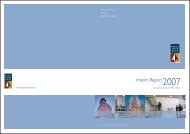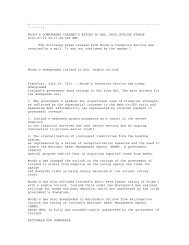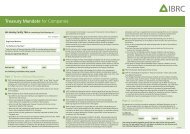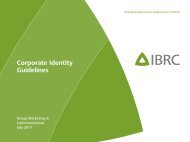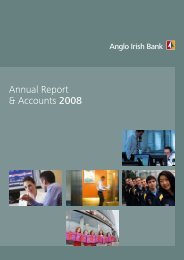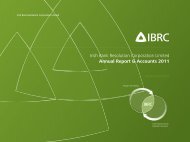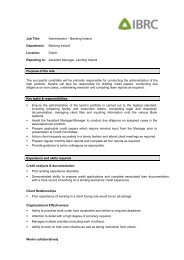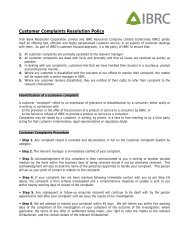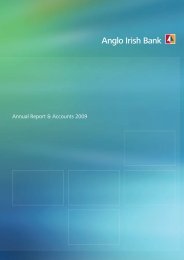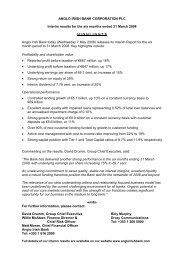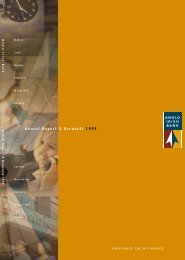IBRC annual report for 2011 - Irish Bank Resolution Corporation ...
IBRC annual report for 2011 - Irish Bank Resolution Corporation ...
IBRC annual report for 2011 - Irish Bank Resolution Corporation ...
You also want an ePaper? Increase the reach of your titles
YUMPU automatically turns print PDFs into web optimized ePapers that Google loves.
Notes to the financial statements continued1. General in<strong>for</strong>mation and accounting policies continued1.10 Financial assetsFinancial assets are classified into the following categories: financial assets at fair value through profit or loss; loans and receivables; heldto-maturityinvestments; and available-<strong>for</strong>-sale financial assets. Management determines the classification of financial assets at initialrecognition.Financial assets at fair value through profit or lossThis category has two sub-categories: financial assets held <strong>for</strong> trading, and those designated at fair value through profit or loss atinception. A financial asset is classified in this category if acquired principally <strong>for</strong> the purpose of selling in the short term or if sodesignated by management.A financial asset may be designated at fair value through profit or loss in the following circumstances:a) it eliminates or significantly reduces a measurement or recognition inconsistency that would otherwise arise from measuringassets or liabilities or recognising gains and losses arising on them on different bases; orb) a group of financial assets, financial liabilities or both is managed and its per<strong>for</strong>mance is evaluated on a fair value basis, inaccordance with a documented risk management or investment strategy; orc) a financial instrument contains one or more embedded derivatives that significantly modify the cash flows arising from theinstrument and would otherwise need to be accounted <strong>for</strong> separately.The principal categories of financial assets designated at fair value through profit or loss are (a) policyholders’ assets underpinninginvestment contracts issued by the Group's assurance company - fair value designation significantly reduces the measurementinconsistency that would arise if these assets were classified as available-<strong>for</strong>-sale; and (b) certain investment securities containingembedded derivatives that are not closely related to the host contracts.Interest on financial assets at fair value through profit or loss held on own account is included in net interest income. Other gains andlosses arising from changes in fair value are included directly in the income statement within financial assets designated at fair value.Loans and receivablesLoans and receivables are non-derivative financial assets with fixed or determinable payments that are not quoted in an active marketand which are not classified as available-<strong>for</strong>-sale. They arise when the Group provides money to a customer with no intention of tradingthe receivable. Loans and receivables are initially recognised at fair value including direct and incremental transaction costs, and aresubsequently carried on an amortised cost basis.Held-to-maturity investmentsHeld-to-maturity investments are non-derivative financial assets with fixed or determinable payments and fixed maturities that theGroup's management has the positive intention and ability to hold to maturity. Were the Group to sell other than an insignificantamount of held-to-maturity assets, the entire category would be tainted and reclassified as available-<strong>for</strong>-sale financial assets.Available-<strong>for</strong>-sale financial assetsAvailable-<strong>for</strong>-sale financial assets are those intended to be held <strong>for</strong> an indefinite period of time, which may be sold in response to needs<strong>for</strong> liquidity or changes in interest rates, exchange rates, asset prices or other factors.Purchases of financial assets at fair value through profit or loss, held-to-maturity investments and available-<strong>for</strong>-sale financial assets arerecognised on a trade date basis, being the date on which the Group commits to purchase the asset. Loans and receivables arerecognised when funds are advanced to the borrowers. Financial assets are initially recognised at fair value plus directly attributabletransaction costs, with the exception of financial assets carried at fair value through profit or loss whose transaction costs are takendirectly to the income statement. Financial assets are derecognised when the rights to receive cash flows from the financial assets haveexpired or where the Group has transferred substantially all the risks and rewards of ownership.Available-<strong>for</strong>-sale financial assets and financial assets at fair value through profit or loss are subsequently carried at fair value. Loans andreceivables and held-to-maturity investments are subsequently carried at amortised cost using the effective interest rate method.Gains and losses arising from changes in the fair value of financial assets at fair value through profit or loss held on own account areincluded within fair value movements in the income statement in the period in which they arise. Gains and losses arising from changes inthe fair value of available-<strong>for</strong>-sale financial assets are recognised in other comprehensive income and accumulated under a separatecomponent of shareholders' equity until the financial assets are derecognised or impaired, at which time the cumulative gain or losspreviously recognised in other comprehensive income is transferred to the income statement. Interest on both financial assets at fairvalue through profit or loss held on own account and available-<strong>for</strong>-sale financial assets is <strong>report</strong>ed in interest and similar income.Interest is calculated using the effective interest rate method and is recognised in profit or loss. Dividends on available-<strong>for</strong>-sale equityinstruments are recognised in profit or loss when the Group's right to receive payment is established.The <strong>Bank</strong> accounts <strong>for</strong> investments in subsidiary undertakings at cost less provisions <strong>for</strong> impairment.1.11 Financial liabilitiesFinancial liabilities other than those at fair value through profit or loss are initially recognised at fair value, being their issue proceeds netof transaction costs incurred. Transaction costs on liabilities at fair value are expensed to the income statement. All liabilities, other thanthose designated at fair value through profit or loss, are subsequently carried at amortised cost. For financial liabilities measured atamortised cost any difference between initial fair value and redemption value is recognised in profit and loss using the effective interestrate method.46



